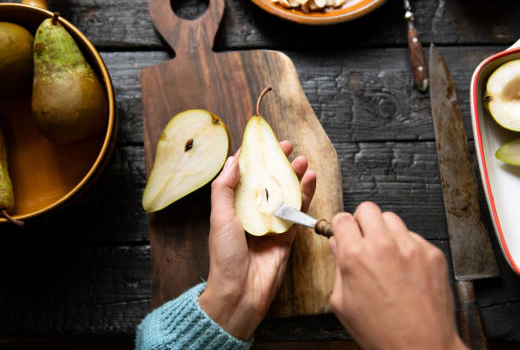Can You Freeze Pears? Yes!

Stacy’s Parmesan Garlic Flavored Chips: A Delectable Snack Worth Savoring
June 4, 2025
How to Safely Extinguish a Charcoal Grill
June 8, 2025As our delicious best pear recipes prove, fresh pears are incredibly versatile, working well in both sweet and savory dishes. Cranberry-pear pork chops, anyone? About 93% of U.S. pears are grown in a few western states, including California, Washington, and Oregon. Because of the climate in these growing regions, the pear season is short, running from August through October.
So, you might be thinking, “Beyond their brief in-season window, can you freeze pears?” The answer is a resounding yes, and there are several ways to do it. Freezing pears allows you to enjoy juicy Bartlett, sweet Anjou, and crisp Bosc pears all year long. When the season is in full swing, head to your local farmers market or grocery store to stock up on this autumn fruit, then follow our Test Kitchen guide for freezing pears.
How to Freeze Pears Perfectly Every Time
When choosing pears for freezing, opt for firm, ripe fruit for the best results. How much do you need? Two to three pounds of fresh pears will yield about 1 quart of frozen pears, depending on your chosen freezing method. Then, follow these steps to learn how to freeze pears in syrup.
Prepare the Pears
If your fresh pears aren’t ready to freeze immediately, store them in the refrigerator. (If you missed it, we’ve got a whole guide on where to store all your produce to end the “fridge or counter?” debate.)
- Rinse and drain a small amount of fresh, whole pears under cold water. Remove the pears from the water; do not let them soak.
- Peel, halve, and core the pears.
- Treat the cut fruit with an anti-darkening solution by immersing it in an acidic water bath for about 3 minutes. To 1 quart of water, you can add any of the following:
- ¾ teaspoon ascorbic acid
- 3 tablespoons fresh lemon juice
- ¼ teaspoon citric acid
- Drain the fruit.
Make the Syrup and Pack the Containers
Prepare a syrup for freezing the pears. Choose a heavy or light syrup depending on the sweetness of the fruit (and your taste preferences). To prepare the syrup, combine the following amounts of sugar and water in a large saucepan. Heat until the sugar dissolves. Skim off any foam if necessary. Chill the syrup when ready to freeze the fruit.
- For a very light syrup: Use 1 ⅔ cups sugar and 4 cups water for 4 ¼ cups of syrup.
- For a medium syrup: Use 2 ⅔ cups sugar and 4 cups water for 4 ⅔ cups of syrup.
- For a heavy syrup: Use 4 cups sugar and 4 cups water for 5 ¾ cups of syrup.
Next, you’ll need to measure your cut pears and the cooled syrup for freezing. For every 2 cups of pears, use ½ to ⅔ cup of syrup. Pour the syrup into freezer-safe containers, allowing for the recommended headspace:
- For containers with wide top openings and straight or slightly flared sides: Leave ½ inch of headspace for pint containers and 1 inch of headspace for quart containers.
- For narrow-top containers and freezer-safe jars: Leave ¾ inch of headspace for pint containers and 1 ½ inches of headspace for quart containers.
Freeze the Pears
- Wipe the container rims. Seal according to the manufacturer’s directions, pressing out as much air as possible. If necessary, use freezer tape to seal the lid edges to ensure your frozen pears are well-sealed.
- Label each container with its contents, quantity, and date.
- Place packaged foods in the freezer in batches to ensure the food freezes quickly and solidly. Leave some space between packages for air circulation. Once completely frozen, you can arrange the packages more compactly.
- Frozen fruit is best when used within 8 to 10 months. Thaw the fruit by placing the container in the refrigerator or a bowl of cold water.
Enjoy your frozen pears in smoothies, baked goods, or as a sweet treat all year long!




